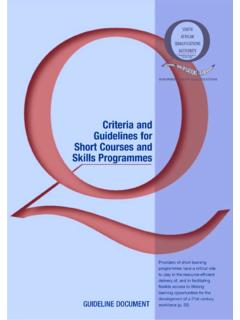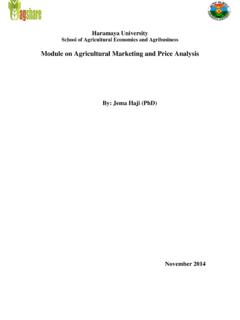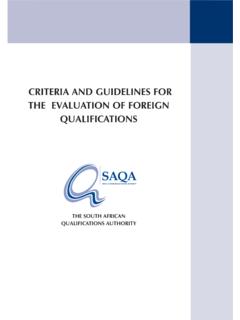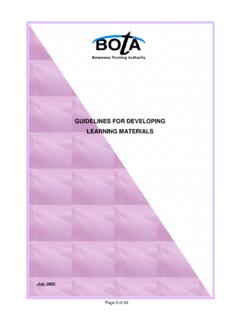Transcription of DEVELOPING LEARNING PROGRAMMES
1 DEVELOPING LEARNING PROGRAMMESfor NQF-registered qualifications and unit standardsA STEP-BY-STEP GUIDEDESIGN DOWNDELIVER UPPURPOSEOUTCOMESASSESSMENTACTIVITIESD eveloping LEARNING PROGRAMMES for NQF-registered Qualifications and Unit StandardsiDEVELOPING LEARNING PROGRAMMESfor NQF-registered qualifications and unit standardsA STEP-BY-STEP GUIDEOUTCOMESQUALIFICATIONUNIT STANDARD/EXIT LEVEL OUTCOMEUNIT STANDARD/EXIT LEVEL OUTCOMEUNIT STANDARD/EXIT LEVEL OUTCOMED eveloping LEARNING PROGRAMMES for NQF-registered Qualifications and Unit StandardsiiWe are grateful for the generous funding of DANIDA (Danish Development Agency), provided through the Support to Education and skills Development (SESD) Programme that made the publication and distribution of this manual Manager:Joy PapierDesign and Reworking:Lesley DanielDevelopment Team:J.
2 Papier, , T. McBride, N. Prinsloo, L. Daniel, J. Martin. Additional input from:A. Oberholzer, J. Keevy and R. HeynsEditing:Mary MonteithLayout:Simon PamphilonCover design:Les DanielPrinting:Creda CommunicationsWe would like to express a special thank you to all the educators who participated in our workshop series and assisted in the development of this manual through their constructive feedback and commentPublished by SAQA under the SESD ProgrammeCopyright South African Qualifications Authority 2005NB! As with all other SAQA publications, this manual may not be reproduced for profit and any quotations must be appropriately acknowledgedACKNOWLEDGEMENTSD eveloping LEARNING PROGRAMMES for NQF-registered Qualifications and Unit StandardsiiiTABLE OF CONTENTSA conyms and terminologyivSECTION A: INTRODUCTIONWho is this manual for?
3 1 Why is this manual necessary?1 What are the origins of this manual?1 What sources have we consulted?1 How has this manual been structured?2 SECTION B : STARTING FROM THE SAME PAGEIs there a difference between a curriculum and a LEARNING programme?3 How does SAQA define Curriculum?3 How does SAQA define a LEARNING programme?3 What is the difference between a qualification and a LEARNING programme?4A Design Down, Deliver Up Approach5 Qualifications, Unit Standards and Outcomes6 How is a level described?6 What are credits?7 What is Applied Competence??8 Where do the Critical Cross Field Outcomes fit in?8 What does integrated assessment entail?9 How is RPL possible?9 SECTION C : THE STEP-BY-STEP APPROACHStep 1: Analysing the Qualification10 Step 2: Analysing the Unit Standard12 Step 3: Analysing the Specific/ LEARNING Outcome13 Step 4: Integrating outcomes 15 Concluding comments16 APPENDIX A: Level Descriptors for Levels 1 B: Sample LEARNING and assessment activities derived from C: LEARNING /Assessment D:An example fo designing a LEARNING programme from one unit E.
4 Principles of LEARNING PROGRAMMES for NQF-registered Qualifications and Unit StandardsivACRONYMS AND TERMINOLOGYTerm/acronym Description Assessment A structured process for gathering evidence and making judgments about an individual s performance in relation to registered national standards and qualifications Applied competence A learner s ability to integrate concepts, ideas and actions in authentic, real-life contexts which is expressed as practical, foundational and reflexive competence CHEC ouncil on Higher EducationELOExit Level Outcomes: the outcomes to be achieved by a qualifying learner at the point at which s/he leaves the programme leading to a qualificationETQAE ducation and Training Quality AssurerFormative assessment Assessment that takes place during the process of teaching and LEARNING Integrated assessment A form of assessment that permits the learner to demonstrate applied competence and that uses a range of formative and summative assessment methods LEARNING programme The sequential LEARNING activities associated with curriculum implementation.
5 Leading to the achievement of a particular qualification or part qualification NQF National Qualifications Framework NSB National Standards Bodies Programme A coherent set of courses, leading to a qualification Qualification A planned combination of LEARNING outcomes with a defined purpose(s) that is intended to provide qualifying learners with applied competence and a basis for further learningRPLR ecognition of Prior LearningSAQA South African Qualifications Authority Summative assessment An assessment undertaken to make a judgment about achievement. This is carried out at the end of a particular period of learningUnit standard Registered statements of desired education and training outcomes and their associated assessment criteriaDeveloping LEARNING PROGRAMMES for NQF-registered Qualifications and Unit Standards1 SECTION A: INTRODUCTIONWho is this manual for?
6 This manual is for any educator who would like a step-by-step approach to DEVELOPING LEARNING PROGRAMMES using outcomes, whether the outcomes are contained within unit standards or full qualifications. It is not intended to be an academic paper or a policy document. There are many of those that can be consulted for more academic purposes. The focus of this manual is to set out a curriculum development process, using, as far as possible, plain language that can serve as a starting point for those who need guidance on how to go about it. Why is this manual necessary?SAQA has become increasingly aware of the need for guidance in the construction of LEARNING PROGRAMMES for qualifications based on stated outcomes.
7 Now that a substantial number of qualifications and unit standards have been registered and are on the National Learners Records Database, providers are faced with the responsibility of planning the LEARNING and assessment processes that support the achievement of outcomes and enable the quality assurance of such achievement. There are undoubtedly many different ways of designing LEARNING PROGRAMMES , and we would not want to regulate away the creativity of providers. What we are offering here is one approach to LEARNING programme development. You need to decide whether or not it works for you. The suggestions in this manual are not prescribed!What are the origins of this manual?Hundreds of educators (teachers/lecturers/trainers/facilitator s) across various institutions have benefited from exposure to the workshop process contained in this manual, and hence our decision to make it available to a wider audience.
8 The process may be adapted if necessary, since contexts, resources and student needs will vary. The design process will assist you to plan appropriately. What sources have we consulted?This manual has drawn on other SAQA documents, particularly the National Qualifications Framework and Curriculum Development (2000), Guidelines for the Assessment of NQF registered Unit Standards and Qualifications (1999) and the draft document Criteria and Guidelines for Integrated Assessment (2004). DEVELOPING LEARNING PROGRAMMESFOR NQF-REGISTERED QUALIFICATIONS AND UNIT STANDARDSD eveloping LEARNING PROGRAMMES for NQF-registered Qualifications and Unit Standards2In addition, we have used SAQA s advocacy workshop materials which draw on other sources.
9 However, the most valuable resource for this manual has been the input we obtained at workshops, over an extensive period of time, through the questions and comments of our has this manual been structured?There are three sections in this manual. Section A sketches the background to this document. Section B sets out some important concepts and their definitions to ensure that everyone starts from the same page and that terminology has the same meaning for all. This is essential to the step-by-step approach in Section C. Section C is a hands on session in a workshop format and is intended to provide a structure for your programme planning. We have used mind-maps for easy analysis of the qualification, unit standard and outcomes.
10 The Venn Diagram contains suggestions for a variety of activities that can be used for LEARNING and assessment. It is hoped that educators will work through this manual in teams rather than individually, and possibly across LEARNING areas, so as to benefit from the insight and ideas of their LEARNING PROGRAMMES for NQF-registered Qualifications and Unit Standards3 SECTION B : STARTING FROM THE SAME PAGEE nsure that you understand the following concepts before you start the real task of programme design it helps to have the bigger picture in place there a difference between a curriculum and a LEARNING programme?Many people use the terms curriculum and LEARNING programme interchangeably, as they are so closely related.






